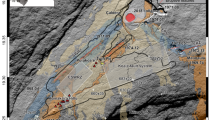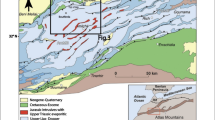Abstract
The Iraq Southern Desert (SD) needs detailed studies to explore the subsurface, especially the deep and concealed basement. The aim of this work is to interpret the airborne magnetic survey data of the SD, which has a thick Phanerozoic sedimentary cover. The basement has not been imaged by deep seismic or even accessed by exploration wells. Magnetic edge-detection filters: total horizontal gradient, improved logistic, and second-vertical gradient (in the form of the signum transform) are utilized to help define the structural framework of the basement. The results of edge-detection filters are utilized in determining basement-dominated fault systems and aid in defining magnetic susceptibility boundaries. We have found a remarkable relationship between the interpreted fault systems and previously drilled hydrocarbon wells that could be used to indicate fault-bound structural traps. The results of edge filters also show linear clustering of magnetic structures that may indicate a distinctive phenomenon characterized old and reworked basement. The calculated magnetic susceptibilities utilizing two-dimensional forward modeling are consistent with metamorphic rocks and igneous intrusions. Further, two north–south-trending magnetic zones are displaced by a northeast-southwest-trending strike-slip movement. These zones are here considered as the northward projection of the Ediacaran Al Amar Suture in Iraq. We suggest a novel approach that combines edge-detection filters with a depth estimation method that can be successfully applied to discovering the stable (inner) parts of platforms with deep and concealed basements.










Similar content being viewed by others
Data availability
The magnetic data belongs to GEOSURV and cannot be used without prior permission.
References
Abdulrahim, H., & Al-Rahim, A. M. (2019). Determinations of the depths to magnetic sources over Al-Ma′aniyah depression area-southwest Iraq using the aeromagnetic data and their tectonic implication. Iraqi Journal of Science, 60(1), 91–102. Available at: https://ijs.uobaghdad.edu.iq/index.php/eijs/article/view/597
Ajibola, R. F., Wei, Q., Oladotun, S. O., Babatunde, B. D., Mosaad, A. H. A., Claire, D., & Uti, I. M. (2021). Airborne magnetic and radiometric mapping for litho-structural settings and its significance for bitumen mineralization over Agbabu bitumen-belt southwestern Nigeria. Journal of African Earth Sciences, 180, 104222. https://doi.org/10.1016/j.jafrearsci.2021.104222
Al-Bahadily, H. A., Al-Rahim, A. M., & Long, A. J. (2024). Postulated Precambrian basement of the Iraq Southern Desert: A new look utilizing magnetic data. In: Çiner, A., et al. Recent Research on Geotechnical Engineering, Remote Sensing, Geophysics and Earthquake Seismology. MedGU 2021. Advances in Science, Technology & Innovation. Springer, Cham. https://doi.org/10.1007/978-3-031-43218-7_78
Al-Bahadily, H. A., Al-Rahim, A. M., & Smith, R. S. (2023). Determination of reactivated regions and faults in the Iraq Southern Desert with the new edge technique, inverse tilt angle of second-gradients (ITAS). Acta Geophysica. https://doi.org/10.1007/s11600-023-01176-4
Al-Banna, A. Sh., & Ali, K. K. (2018). The transition tectonic zone between the two parts of the platform in Iraq: A review study. Iraqi Journal of Science, 59(2C), 1086–1092. Available at: https://ijs.uobaghdad.edu.iq/index.php/eijs/article/view/418
Al-Rahim, A. M. (2017). Enhance the delineation of masked structures in southern Iraq by applying the biharmonic operator to their gravity field. Iraqi Journal of Science, 58(1A), 79–87. Available at: https://ijs.uobaghdad.edu.iq/index.php/eijs/article/view/6203
Al-Rahim, A. M., & Abdulrahim, H. (2021). Gravity study using multi-2.5D modeling and 3D Ma’aniyah depression, southwest of Iraq. Iraqi Geological Journal, 54(2D), 113–124.
Aqrawi, A. A. M. (1998). Paleozoic stratigraphy and petroleum systems of the western and southwestern deserts of Iraq. GeoArabia, 3, 229–248.
Aqrawi, A. A. M., Goff, J. C., Horbury, A., & Sadooni, F. N. (2010). The petroleum geology of Iraq (p. 424). Scientific Press.
Buday, T. (1980). The regional geology of Iraq. Stratigraphy and palaeogeography (Vol. 1). Iraq: Dar Al-Kutub Publishing House, University of Mosul.
Clark, D. A., & Emerson, J. B. (1991). Notes on rock magnetization characteristics in applied geophysical studies. Exploration Geophysics, 22(3), 547–555. https://doi.org/10.1071/EG991547
Cordell, L. (1979). Gravimetric expression of graben faulting in Santa Fecountry and the Espanola Basin. New Mexico Geol. Soc. Guidebook, 30th Field Conf., New Mexico (pp. 59–64).
De Souza, J., & Ferreira, F. J. F. F. (2015). The application of the Signum transform to the interpretation of magnetic anomalies due to prismatic bodies. ASEG Extended Abstracts, 1, 1–5. https://doi.org/10.1071/ASEG2015ab190
Ekwok, S. E., Eldosouky, A. M., Ben, U. C., Alzahrani, H., Abdelrahman, K., Achadu, O.-I.M., Pham, L. T., Akpan, A. E., & Gómez-Ortiz, D. (2022a). Application of high-precision filters on airborne magnetic data: A case study of the Ogoja Region, Southeast Nigeria. Minerals, 12, 1227. https://doi.org/10.3390/min12101227
Ekwok, S. E., Eldosouky, A. M., Ben, U. C., Achadu, O. I. M., Akpan, A. E., Othman, A., & Pham, L. T. (2023). An integrated approach of advanced methods for mapping geologic structures and sedimentary thickness in Ukelle and adjoining region (Southeast Nigeria). Earth Sciences Research Journal, 27(3), 251–258. https://doi.org/10.15446/esrj.v27n3.105868
Ekwok, S. E., Achadu, O.-I.M., Akpan, A. E., Eldosouky, A. M., Ufuafuonye, C. H., Abdelrahman, K., & Gómez-Ortiz, D. (2022b). Depth estimation of sedimentary sections and basement rocks in the Bornu Basin, Northeast Nigeria using high-resolution airborne magnetic data. Minerals, 12, 285. https://doi.org/10.3390/min12030285
Eldosouky, A. M., Elkhateeb, S. O., Mahdy, A. M., Saad, A. A., Fnais, M. S., Abdelrahman, K., & Andráš, P. (2022a). Structural analysis and basement topography of Gabal Shilman area, South Eastern Desert of Egypt, using aeromagnetic data. Journal of King Saud University-Science. https://doi.org/10.1016/j.jksus.2021.101764
Eldosouky, A. M., Pham, L. T., Abdelrahman, K., Fnais, M. S., & Gomez-Ortiz, D. (2022b). Mapping structural features of the Wadi Umm Dulfah area using aeromagnetic data. Journal of King Saud University-Science. https://doi.org/10.1016/j.jksus.2021.101803
Eldosouky, A. M., Pham, L. T., Duong, V.-H., Ghomsi, F. E. K., & Henaish, A. (2022c). Structural interpretation of potential field data using the enhancement techniques: A case study. Geocarto International. https://doi.org/10.1080/10106049.2022.2120548
Eldosouky, A. M., Pham, L. T., & Henaish, A. (2022d). High precision structural mapping using edge filters of potential field and remote sensing data: A case study from Wadi Umm Ghalqa area South Eastern Desert, Egypt. The Egyptian Journal of Remote Sensing and Space Science, 25(2), 501–513. https://doi.org/10.1016/j.ejrs.2022.03.001
Evjen, H. M. (1936). The place of the vertical gradient in gravitational interpretations. Geophysics, 1(1), 127–136. https://doi.org/10.1190/1.1437067
Fouad, S. F. (2012). Tectonic map of Iraq, scale 1:1000000 (3rd ed.). Iraq Geological Survey Publications.
Hamimi, Z., Eldosouky, A. M., Hagag, W., et al. (2023). Large-scale geological structures of the Egyptian Nubian Shield. Science and Reports, 13, 1923. https://doi.org/10.1038/s41598-023-29008-x
Jassim, S. Z. (2006). Late Precambrian development of Arabian Plate. In S. Z. Jassim & J. C. Goff (Eds.), Geology of Iraq (pp. 27–31). Dolin.
Jassim, S. Z., & Buday, T. (2006). Tectonic framework. In S. Z. Jassim & J. C. Goff (Eds.), Geology of Iraq (pp. 45–56). Prague: Dolin.
Lei, K., Fairhead, J. D., Kerrane, T., & Al-Bassam, K. S. (2011). Reprocessing of Iraq magnetic and gravity data. In International workshop on gravity, electrical and magnetic methods and their applications, Beijing.https://doi.org/10.1190/1.3659043
Ma’ala, Kh. A. (2009). Geology of Iraqi Southern Desert. Iraqi Bull. Geol. Min. Special Issue (pp. 35–52)
Mohammed, S. A. G. (2006). Megaseismic section across the northeastern slope of the Arabian Plate, Iraq. Geoarabia, 11(4), 77–90.
Nabighian, M. N., Grauch, V. J. S., Hansen, R. O., LaFehr, T. R., Li, Y., Peirce, J. W., et al. (2005). The historical development of the magnetic method in exploration. Geophysics, 70, 33ND-61ND.
Oasis Geosoft Montaj. (2014). SPI.GX. Help guide. Geosoft Inc.
Obiora, D. N., Oha, I. A., Ihedike, A. O., et al. (2022). Comparative depth estimates and modeling of magnetic anomalies over the Nkalagu area, Southeastern Nigeria. Modeling Earth Systems and Environment, 8, 1291–1309. https://doi.org/10.1007/s40808-021-01155-y
Oguama, B. E., Okeke, F. N., & Obiora, D. N. (2021). Mapping of subsurface structural features in some parts of Anambra Basin, Nigeria, using aeromagnetic data. Modeling Earth Systems and Environment, 7, 1623–1637. https://doi.org/10.1007/s40808-020-00894-8
Pham, L. T., Van, V. T., Le, T. S., et al. (2020). Enhancement of potential field source boundaries using an improved logistic filter. Pure and Applied Geophysics, 177, 5237–5249. https://doi.org/10.1007/s00024-020-02542-9
Phillips, J. (2000). Locating magnetic contacts: A comparison of the horizontal gradient, analytic signal, and local wavenumber methods. In 70th annual international meeting, society of exploration geophysics, expanded abstracts (pp. 402–405).
Saada, A. S., Eldosouky, A. M., Abdelrahman, K., Al-Otaibi, N., Ibrahim, E., & Ibrahim, A. (2021). New insights into the contribution of gravity data for mapping the lithospheric architecture. Journal of King Saud University-Science. https://doi.org/10.1016/j.jksus.2021.101400
Salako, K. A., Adetona, A. A., Rafiu, A. A., Alhassan, U. D., Alkali, A., & Aliyu, A., (2022). Determination of sedimentary thickness of parts of middle Benue Trough, Northeast Nigeria, using high-resolution aeromagnetic data. In: Advances in geophysics, tectonics and petroleum geosciences. CAJG 2019. Advances in Science, Technology & Innovation. Springer, Cham. https://doi.org/10.1007/978-3-030-73026-0_69
Sharland, P. R., Archer, R., Casey, D. M., Davies, R. B., Hall, S. H., Heward, A. P., Horbury, A. D., & Simmons, M. D. (2001). Arabian plate sequence stratigraphy. GeoArabia Special Publication, 2, 371.
Sissakian, V., & Fouad, S. F. (2012). Geological Map of Iraq, scale 1:1000000 (4th ed.). Iraq Geological Survey Publications.
Smith, R. S., Thurston, J. B., Dai, T.-F., & MacLeod, I. N. (1998). iSPI™—the improved source parameter imaging method. Geophysical Prospecting, 46, 141–151.
Spector, A., & Grant, F. S. (1970). Statistical models for interpreting aeromagnetic data. Geophysics, 35, 293–302.
Stern, R. J., & Johnson, P. (2010). Continental lithosphere of the Arabian Plate: A geologic, petrologic, and geophysical synthesis. Earth-Science Reviews, 101, 29–67.
Swain, C. J. (2000). Reduction-to-the-pole of magnetic data with variable field direction, and its stabilisation at low inclinations. Exploration Geophysics, 31, 78–83.
Thurston, J., Guillon, J.-C., & Smith, R. (1999). Model-independent depth estimation with the SPI™ method. SEG Expanded Abstracts, 18, 403–406.
Thurston, J. B., & Smith, R. S. (1997). Automatic conversion of magnetic data to depth, dip, and susceptibility contrast using the SPI™ method. Geophysics, 62, 807–813.
Thurston, J. B., Smith, R. S., & Guillon, J.-C. (2002). A multimodel method for depth estimation from magnetic data. Geophysics, 67, 555–561.
Verduzco, B., Fairhead, J. D., & Green, C. M. (2004). & MacKenzie, New insights into magnetic derivatives for structural mapping. The Leading Edge, 23, 116–119. https://doi.org/10.1190/1.1651454
Acknowledgements
We are thankful to GEOSURV for the permission of using the magnetic data and software. We are also grateful to Ahmed S. Mousa (Senior Chief Geophysicist at GEOSURV) and John Milsom (Geophysicist, Gladestry Associates, UK) and the two anonymous reviewers for their valuable comments that improved drastically the manuscript.
Funding
This research did not receive any specific grant from funding agencies in the public, commercial, or not-for-profit sectors.
Author information
Authors and Affiliations
Contributions
Hayder A. Al-Bahadily and Richard S. Smith wrote the main manuscript text and Ali M. Al-Rahim is supervisor who discussed ideas. All authors reviewed the manuscript.
Corresponding author
Ethics declarations
Conflict of interest
The author declares no conflicts of interest.
Additional information
Publisher's Note
Springer Nature remains neutral with regard to jurisdictional claims in published maps and institutional affiliations.
Rights and permissions
Springer Nature or its licensor (e.g. a society or other partner) holds exclusive rights to this article under a publishing agreement with the author(s) or other rightsholder(s); author self-archiving of the accepted manuscript version of this article is solely governed by the terms of such publishing agreement and applicable law.
About this article
Cite this article
Al-Bahadily, H.A., Al-Rahim, A.M. & Smith, R.S. Tectonic elements and structural framework deduced from magnetic data of the Southern Desert, Iraq. Pure Appl. Geophys. (2024). https://doi.org/10.1007/s00024-024-03460-w
Received:
Revised:
Accepted:
Published:
DOI: https://doi.org/10.1007/s00024-024-03460-w




